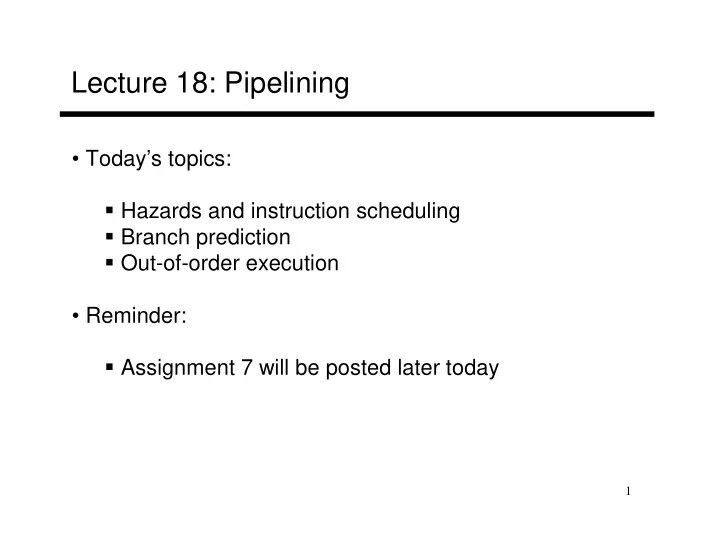

Lecture 18: Pipelining • Today’s topics: � Hazards and instruction scheduling � Branch prediction � Out-of-order execution • Reminder: � Assignment 7 will be posted later today 1
Structural Hazards • Example: a unified instruction and data cache � stage 4 (MEM) and stage 1 (IF) can never coincide • The later instruction and all its successors are delayed until a cycle is found when the resource is free � these are pipeline bubbles • Structural hazards are easy to eliminate – increase the number of resources (for example, implement a separate instruction and data cache) 2
Data Hazards 3
Bypassing • Some data hazard stalls can be eliminated: bypassing 4
Example add $1, $2, $3 lw $4, 8($1) 5
Example lw $1, 8($2) lw $4, 8($1) 6
Example lw $1, 8($2) sw $1, 8($3) 7
Control Hazards • Simple techniques to handle control hazard stalls: � for every branch, introduce a stall cycle (note: every 6 th instruction is a branch!) � assume the branch is not taken and start fetching the next instruction – if the branch is taken, need hardware to cancel the effect of the wrong-path instruction � fetch the next instruction (branch delay slot) and execute it anyway – if the instruction turns out to be on the correct path, useful work was done – if the instruction turns out to be on the wrong path, hopefully program state is not lost 8
Branch Delay Slots 9
Pipeline without Branch Predictor IF (br) Reg Read Compare PC Br-target PC + 4 10
Pipeline with Branch Predictor IF (br) Reg Read Compare PC Br-target Branch Predictor 11
Bimodal Predictor 14 bits Table of Branch PC 16K entries of 2-bit saturating counters 12
2-Bit Prediction • For each branch, maintain a 2-bit saturating counter: if the branch is taken: counter = min(3,counter+1) if the branch is not taken: counter = max(0,counter-1) … sound familiar? • If (counter >= 2), predict taken, else predict not taken • The counter attempts to capture the common case for each branch 13
Slowdowns from Stalls • Perfect pipelining with no hazards � an instruction completes every cycle (total cycles ~ num instructions) � speedup = increase in clock speed = num pipeline stages • With hazards and stalls, some cycles (= stall time) go by during which no instruction completes, and then the stalled instruction completes • Total cycles = number of instructions + stall cycles 14
Multicycle Instructions • Multiple parallel pipelines – each pipeline can have a different number of stages • Instructions can now complete out of order – must make sure that writes to a register happen in the correct order 15
� � � � � � � � An Out-of-Order Processor Implementation Reorder Buffer (ROB) Instr 1 T1 Branch prediction Instr 2 T2 and instr fetch Register File Instr 3 T3 R1-R32 Instr 4 T4 Instr 5 T5 Instr 6 T6 R1 R1+R2 R2 R1+R3 Decode & BEQZ R2 Rename R3 R1+R2 T1 R1+R2 ALU ALU ALU R1 R3+R2 T2 T1+R3 BEQZ T2 Instr Fetch Queue Results written to T4 T1+T2 ROB and tags T5 T4+T2 broadcast to IQ Issue Queue (IQ) 16
Title • Bullet 17
Recommend
More recommend